THE DESMIDS of THURSLEY
COMMON
by William Ells
Coniferae, Walnut Tree Lane, Loose, Maidstone, Kent. ME15 9RG.
UK.
Thursley Common, Surrey, England is a Site of Special
Scientific Interest (SSSI) . Comprising 326 hectares owned by
English Nature. The bog is of great interest to microscopists
both amateur and professional, and in particular to desmid
enthusiasts like myself.
David Bellamy, Britain's best known botanist, has stated that
Thursley Common is his favourite SSSI. A place where black bog
rush and scorpion moss vie with sheets of desmids and
other algae for their place in the sun.
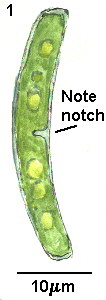 My own interest
in desmids started in 1979 and after reading in a paper by G.A.
Early in 'Microscopy' In Praise of Desmids (with
observations on the desmid flora of Thursley Common) in 1981,
that this was the first paper to be published in 'Microscopy' on
these important unicellular freshwater plants since 1961. I
decided to try and specialise.
My own interest
in desmids started in 1979 and after reading in a paper by G.A.
Early in 'Microscopy' In Praise of Desmids (with
observations on the desmid flora of Thursley Common) in 1981,
that this was the first paper to be published in 'Microscopy' on
these important unicellular freshwater plants since 1961. I
decided to try and specialise.
After spending some time examining the local ponds and the
only acid bog in Kent at Hothfield and found altogether only
about 25 species, although in one small pond record numbers of a
single species - Staurastrum tetracerum (Kütz.) Ralfs
1845. I decided it was time to visit the source of Mr. Early's
impressive list. I found Thursley bog to be a typical acid bog
with bog cotton and two of the three British species of the
insectivorous plant the Sundew Drosera rotundifolia
& D. intermedia good indicators of acid conditions.
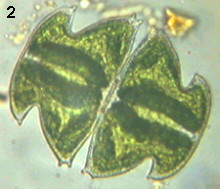 I did not find
sheets of desmids, however I did find the rare Roya obtusa
(Bréb) W.&.G.S.West 1896. Fig 1. and the not very common Micrasterias
oscitans Ralfs 1848 Fig 2. Mr. Early in a letter in July
1988 informed me his list of species/varieties now numbered 110
but did not include R. obtusa or M. oscitans.
Neither did it include Staurastrum muricatum (Bréb)
Ralfs 1848. or Pleurotaenium minutum (Ralfs) Delp. 1877
var. minutum. We discovered his list included the latter
desmid as Penium minutum. W.&.G. S. West confusing
matters. In fact this desmid has been in seven different genera,
it was proposed in a paper by Bando (1988) to transfer the Pleurotaenium
minutum group to a new genera Haplotaenium I do not
know if this has been universally adopted.
I did not find
sheets of desmids, however I did find the rare Roya obtusa
(Bréb) W.&.G.S.West 1896. Fig 1. and the not very common Micrasterias
oscitans Ralfs 1848 Fig 2. Mr. Early in a letter in July
1988 informed me his list of species/varieties now numbered 110
but did not include R. obtusa or M. oscitans.
Neither did it include Staurastrum muricatum (Bréb)
Ralfs 1848. or Pleurotaenium minutum (Ralfs) Delp. 1877
var. minutum. We discovered his list included the latter
desmid as Penium minutum. W.&.G. S. West confusing
matters. In fact this desmid has been in seven different genera,
it was proposed in a paper by Bando (1988) to transfer the Pleurotaenium
minutum group to a new genera Haplotaenium I do not
know if this has been universally adopted.
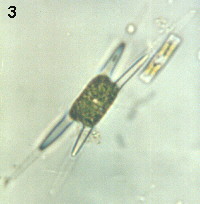 On the 10th. of
July 1992 after a prolonged spell of dry weather there was very
little water in the boggy area, I collected from two of the
wettest places where bog cotton was growing and also from some of
the pools beside the bridle path which were also very low. In the
first of these pools I found Closterium acutum (Bréb)
Ralfs, conjugating and zygospores forming, a rare occurrence Figs
3 & 4.
On the 10th. of
July 1992 after a prolonged spell of dry weather there was very
little water in the boggy area, I collected from two of the
wettest places where bog cotton was growing and also from some of
the pools beside the bridle path which were also very low. In the
first of these pools I found Closterium acutum (Bréb)
Ralfs, conjugating and zygospores forming, a rare occurrence Figs
3 & 4.
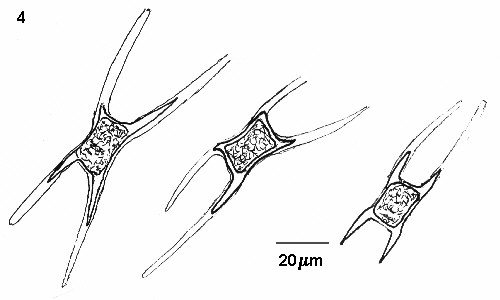
In the third pool I found the not very common Spirotaenia
condensata (Bréb) Ralfs 1848. Fig 5. Although I have now
made several visits and a friend has also given me a sample, I
have not found as many species/varieties as Mr. Early.

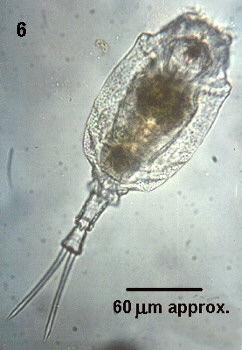 Not a
desmid , but I could not resist putting in a microgaph taken with
flash of a live rotifer I have not seen elsewhere, Fig.6. Trichotria
tetractis from a sample collected at Thursley in 1988.
Not a
desmid , but I could not resist putting in a microgaph taken with
flash of a live rotifer I have not seen elsewhere, Fig.6. Trichotria
tetractis from a sample collected at Thursley in 1988.
There are no restrictions on entry to the site, however you
should get a permit to collect samples from Thursley from English
Nature, The Countryside Management Centre, Coldharbour Farm, Wye,
Ashford, Kent. TN25 5DB. Collect about 100 ml. from several
points rather than a litre from any one place. If you decant each
sample from one tube to another through a tea strainer you will
avoid taking away macro fauna such as water beetles. If you have
with you a suitable flat container, a small photo' developing
dish is ideal, you can examine any beetles, water mites, etc.
before returning them to the bog. TAKE ONLY WHAT YOU REALLY NEED.
Acknowledgements:- Many thanks to Mr. Eric
Hollowday for identifying the rotifer. To Alan Brook Emeritus
Professor of Life Sciences at The University of Buckingham, for a
copy of the paper by Bando. And to the Editors of 'Micscape' for
scanning my photomicrographs for publication.
References:-
Bando 1988. Haplotaenium (nov.com) Journal of
Japanese Botany, Vol. 63. No. 5.
Early. G.A. 1981 In Praise of Desmids (with
observations on the desmid flora of Thursley Common) Microscopy,
Journal of the QMC. Jan-June 1981 Vol.34. Part 3. pp 207-213.
© Microscopy UK or their
contributors.
First published in Micscape Magazine, April
1998 ( ISSN 1365 - 070x )
Article at
http://www.microscopy-uk.net/mag/art98/desthurs.html
Please report any Web problems
or offer general comments to the Micscape Editor,
via the contact on current Micscape Index.
Micscape is the on-line monthly
magazine of the Microscopy UK web
site at Microscopy-UK
WIDTH=1
© Onview.net Ltd, Microscopy-UK, and all contributors 1995 onwards. All rights
reserved. Main site is at www.microscopy-uk.org.uk with full mirror at www.microscopy-uk.net.
 My own interest
in desmids started in 1979 and after reading in a paper by G.A.
Early in 'Microscopy' In Praise of Desmids (with
observations on the desmid flora of Thursley Common) in 1981,
that this was the first paper to be published in 'Microscopy' on
these important unicellular freshwater plants since 1961. I
decided to try and specialise.
My own interest
in desmids started in 1979 and after reading in a paper by G.A.
Early in 'Microscopy' In Praise of Desmids (with
observations on the desmid flora of Thursley Common) in 1981,
that this was the first paper to be published in 'Microscopy' on
these important unicellular freshwater plants since 1961. I
decided to try and specialise.  I did not find
sheets of desmids, however I did find the rare Roya obtusa
(Bréb) W.&.G.S.West 1896. Fig 1. and the not very common Micrasterias
oscitans Ralfs 1848 Fig 2. Mr. Early in a letter in July
1988 informed me his list of species/varieties now numbered 110
but did not include R. obtusa or M. oscitans.
Neither did it include Staurastrum muricatum (Bréb)
Ralfs 1848. or Pleurotaenium minutum (Ralfs) Delp. 1877
var. minutum. We discovered his list included the latter
desmid as Penium minutum. W.&.G. S. West confusing
matters. In fact this desmid has been in seven different genera,
it was proposed in a paper by Bando (1988) to transfer the Pleurotaenium
minutum group to a new genera Haplotaenium I do not
know if this has been universally adopted.
I did not find
sheets of desmids, however I did find the rare Roya obtusa
(Bréb) W.&.G.S.West 1896. Fig 1. and the not very common Micrasterias
oscitans Ralfs 1848 Fig 2. Mr. Early in a letter in July
1988 informed me his list of species/varieties now numbered 110
but did not include R. obtusa or M. oscitans.
Neither did it include Staurastrum muricatum (Bréb)
Ralfs 1848. or Pleurotaenium minutum (Ralfs) Delp. 1877
var. minutum. We discovered his list included the latter
desmid as Penium minutum. W.&.G. S. West confusing
matters. In fact this desmid has been in seven different genera,
it was proposed in a paper by Bando (1988) to transfer the Pleurotaenium
minutum group to a new genera Haplotaenium I do not
know if this has been universally adopted.  On the 10th. of
July 1992 after a prolonged spell of dry weather there was very
little water in the boggy area, I collected from two of the
wettest places where bog cotton was growing and also from some of
the pools beside the bridle path which were also very low. In the
first of these pools I found Closterium acutum (Bréb)
Ralfs, conjugating and zygospores forming, a rare occurrence Figs
3 & 4.
On the 10th. of
July 1992 after a prolonged spell of dry weather there was very
little water in the boggy area, I collected from two of the
wettest places where bog cotton was growing and also from some of
the pools beside the bridle path which were also very low. In the
first of these pools I found Closterium acutum (Bréb)
Ralfs, conjugating and zygospores forming, a rare occurrence Figs
3 & 4. 

 Not a
desmid , but I could not resist putting in a microgaph taken with
flash of a live rotifer I have not seen elsewhere, Fig.6. Trichotria
tetractis from a sample collected at Thursley in 1988.
Not a
desmid , but I could not resist putting in a microgaph taken with
flash of a live rotifer I have not seen elsewhere, Fig.6. Trichotria
tetractis from a sample collected at Thursley in 1988.